 About Authors:
About Authors:
Awan Bharti*1, Sweta Gautam2
1Department of Pharmacognosy,
Shri Rawatpura Sarkar Institute of Pharmacy, Datia, M.P.
2Department of Pharmacognosy, RKDF College of Pharmacy, Bhopal
*bhartiawan@gmail.com, shwetagautam85@rediffmail
ABSTRACT
Interest in alternative medicine and plant-derived medications that affect the "mind" is growing. Anxiety affects one-eighth of the total population of the world and has become a very important area of research interest in psychopharmacology during this decade. Anxiety, a state of excessive fear, is characterized by motor tension, sympathetic hyperactivity, and apprehension and vigilance syndromes. Benzodiazepines are the major class of compounds used in anxiety and they have remained the most commonly prescribed treatment for anxiety, despite the important unwanted side effects that they produce such as sedation, muscle relaxation, ataxia, amnesia, ethanol and barbiturate potentiation and tolerance. Various types of herbal medicines have been used as anxiolytic drugs in different parts of the world. Folk medicines have particular values, for example, plants that "calm down", tranquilize, and raise mood, such as Passiflora coerulea, Valeriana officinalis, Matricaria recutita, Jatropa cilliata, Salvia guaranitica, Tilia tormentosa, and Tilia europeae. Plants have long been used to treat central nervous system (CNS) disorders.
[adsense:336x280:8701650588]
Reference Id: PHARMATUTOR-ART-1597
INTRODUCTION
At present, anxiety and depression are the most frequent psychiatric condition commonly found and number of population suffers from the conditions at some time during their life[1]. In present era, a sudden holocaust of mental disorders, and recognition of severe side effects and addiction liabilities associated with long term administration of widely prescribed synthetic drugs have aroused the attention of researchers towards natural resources. Plants like Valeriana officinalis, Nardostachys jatamansi, Withania somnifera and Panax ginseng have been used extensively in various traditional systems of therapy because of their adaptogenic and psychotropic properties. Inclusion of these well established CNS affecting plants in the arsenal of modern therapeutics has revived the faith of researchers in the plants [2]. The fear due to height (acrophobia) induces anxiety in the animals when placed on the elevated plus-maze. The ultimate manifestation of anxiety and fear in the animals is exhibited by decrease in motor activity, which is measured by the time spent by the animal in the open arms [3]. Benzodiazepines have been extensively used for the last 40 years to treat several forms of anxiety, but due to their unwanted side effects, alternative treatment strategies with favorable side-effect profiles, credible benefits and moderate costs are of interest, especially in primary care settings. Medicinal plants are a good source to find new remedies for these disorders. In the search for an alternative, more specific, and perhaps cost-free therapy, research has been conducted to investigate natural anxiolytic drugs as well as new antidepressant principles [4].
Actaea spicata(Ranunculaceae)
Actaea spicata Linn. (Ranunculaceae) has been traditionally used for the treatment of various ailments such as rheumatism, inflammation, nerve diseases, lumbago, scrofula and chorea. roots of the plant were extracted using solvents in order of increasing polarity viz., petroleum ether (60-80oC), chloroform, methanol and distilled water. All the crude extracts were evaluated for anti-anxiety activity in mice using elevated plus maze apparatus. Among all these extracts, only methanol extract exhibited significant anti-anxiety activity at a dose of 100 mg/kg in mice with respect to control as well as standard (diazepam, 2 mg/kg)[3].
[adsense:468x15:2204050025]
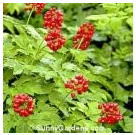
Gelsemium sempervirens(Loganiaceae)
Among medicinal plants,Gelsemium sempervirens (L.) Aiton. (Loganiaceae) has been recommended for relief of anxiety in traditional folk medicines. Antianxiety activity using the elevated plus maze model. Diazepam was used as standard drug. Among various extracts, the methanol extract of G. sempervirens exhibited significant increases in open arm entries and mean time spent in open arms at the dosage of 150 mg/kg. A fraction derived from the methanol extract was also observed to exhibit significant anxiolytic activity at the dose level of 10 mg/kg in the elevated plus maze test [5].
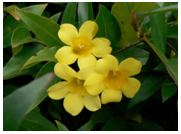
Coriandrum sativum(Umbelliferae)
Coriandrum sativumL. Apiaceae (Umbelliferae) is an annual herb commonly used in Middle Eastern, Mediterranean, Indian, Latin American, African and Southeast Asian cuisine [6]. C. sativum is also used for the management of CNS disorders. C. sativum may be a useful in the management of neurodegenerative diseases, such as Alzheimer's disease, on account of its multifarious effects, that is, memory-improving property, cholesterol-lowering property and anticholinesterase activity [7]. The anti-anxiety activity of hydroalcoholic extract of Coriandrum sativum (Linn.) using different animal models (elevated plus maze, open field test, light and dark test and social interaction test) of anxiety in mice. Diazepam (0.5 mg/kg) was used as the standard and dose of hydroalcoholic extract of C. sativum fruit (50, 100 and 200 mg/kg) was selected as per OECD guidelines. Results suggested that extract of C. sativum at 100 and 200 mg/kg dose produced anti-anxiety effects almost similar to diazepam, and at 50 mg/kg dose did not produce anti-anxiety activity [6].
NOW YOU CAN ALSO PUBLISH YOUR ARTICLE ONLINE.
SUBMIT YOUR ARTICLE/PROJECT AT articles@pharmatutor.org
Subscribe to Pharmatutor Alerts by Email
FIND OUT MORE ARTICLES AT OUR DATABASE
Piper methysticum(Piperaceae)
Kava (Piper methysticum) is a South Pacific psychotropic plant medicine that has anxiolytic activity. This effect is achieved from modulation of GABA activity via alteration of lipid membrane structure and sodium channel function, monoamine oxidase B inhibition, and noradrenaline and dopamine re-uptake inhibition. Use of traditional water soluble extracts of the rhizome (root) of appropriate kava cultivars is advised, in addition to avoidance of use with alcohol and caution with other psychotropic medications. Avoidance of high doses if driving or operating heavy machinery should be mandatory. For regular users routine liver function tests are advised [8].

Turnera aphrodisiaca(Turneraceae)
Turnera aphrodisiacaWard (Turneraceae) has been used traditionally for treatment of anxiety neurosis and as an aphrodisiac. Petroleum ether (60-80 degrees C), chloroform, methanol, and water extracts of T. aphrodisiaca aerial parts were evaluated for anti-anxiety activity in mice using elevated plus-maze apparatus. Among all the extracts, only methanol exhibited significant anti-anxiety activity at a dose of 25 mg/kg with respect to control as well as standard (diazepam, 2 mg/kg)[9].
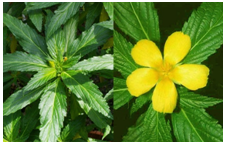
Echium amoenum ( Boraginaceae)
It grows in most of Europe and North Iran. The ethanolic extract of Echium amoenum flowers at the dose of 50 mg/kg increased the percentage of time-spent and the percentage of arm entries in the open arms of the elevated plus-maze (EPM) and decreased the percentage of time-spent in the closed arms of EPM [10].
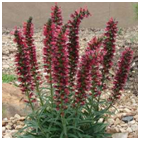
Passiflora incarnate(Passifloraceae)
Passiflora (Passion Flower) consists of the dried arieal parts of Passiflora incarnate collected during the flowering and fruiting period. The genius is native to South America and species are widely cultivated as ornamentals [11]. The petroleum ether, chloroform, methanol, and water extracts of Passiflora incarnata whole plant and sorted out plant parts have been evaluated for their anxiolytic activity using the elevated plus-maze model in mice. The methanol extracts of leaves, stems, flowers, and whole plant exhibited anxiolytic effects at 100, 125, 200 and 300 mg/kg, respectively. These results show that roots and flowers of P. incarnata act as natural adulterants by causing a significant increase in the anxiolytic dose [12]
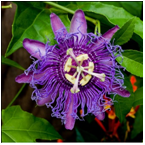
Matricaria recutita(Compositae)
Chamomile flowers are the expanded flower heads and collected from cultivated plants and dried. Chamomiles are cultivated in the south of England and in Belgium, France, Germany [11]. , the research team observed a significantly greater reduction over time in total HAM-D scores for chamomile vs placebo in all participants (P < .05). The team also observed a clinically meaningful but nonsignificant trend for a greater reduction in total HAM-D scores for chamomile vs placebo in participants with current comorbid depression (P = .062). When the team examined the HAM-D core mood item scores, it observed a significantly greater reduction over time for chamomile vs placebo in all participants (P < .05) and a clinically meaningful but nonsignificant trend for a greater reduction over time for chamomile vs placebo in participants without current or past depression (P = .06)[13].

Medicago sativa(Leguminosae)
Medicago sativaLinn. (Leguminosae) has a long tradition of use as an Ayurvedic and Homoeopathic medicine in a variety of central nervous system (CNS) disorders. Traditionally, M. sativa is used to improve the memory, as a rejuvenator, antidiabetic, antioxidant, anti-inflammatory, and in CNS disorders. Only the methanol extract exhibited significant (p < 0.05) anti-anxiety activity by increasing the average time spent, and number of entries in open arms at a dose of 100 mg/kg in mice with respect to the vehicle treated control as well as the standard (2 mg/kg)[14].
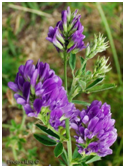
Sarasvata choorna
The anxiolytic activity was evaluated in elevated plus maze (EPM) and the anti-depressant activity were evaluated in forced swimming test (FST). The efficacy of Sarasvata choorna was compared with the standard anti-anxiety (diazepam 2 mg/kg) and anti-depressant (imipramine - 5 mg/kg) drugs. It was observed that Sarasvata choorna at the dose of 390 mg/kg is as effective as standard drugs used in anti-anxiety and anti-depressant activities in mice by increasing time spent in open arm and entries to open arm in EPM model and increasing immobility time in FST model respectively [15].
Clerodendrum Philippinum (Verbenaceae)
Clerodendrum philippinum schauer, Syn: C.fragrans Vent, (Family: Verbenaceae) is a shrub partly wild and often cultivated throughout India [1]. Leaves of C.philippinum have been used as traditional medicine for treatment of colic pain. The leaf extract exhibited anti-fungal activity. The ethanolic extract of Clerodendrum philippinum schauer flowers for anti anxiety and central nervous system depressant activity. The ethanolic extract of the C.philippinum flowers (125 and 250 mg/kg p.o) significantly (P > 0.01) decreased loco motor activity (45.20%, 53.47 %) and significantly (P > 0.01) increased the number of entries, time spent and rears in open arm of the elevated plus maze Model[16].
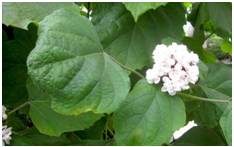
Bacopa monieri(Scrophulariaceae)
It consists of fresh leaves and stems of the plant. Brahmi is found to contain the alkaloids brahmine, herpestine [17].In Ayurveda it is used as nervine tonic and memory enhancer. It has been reported to possess anxiolytic activity in humans [18, 19].
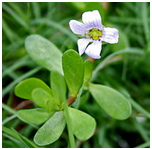
NOW YOU CAN ALSO PUBLISH YOUR ARTICLE ONLINE.
SUBMIT YOUR ARTICLE/PROJECT AT articles@pharmatutor.org
Subscribe to Pharmatutor Alerts by Email
FIND OUT MORE ARTICLES AT OUR DATABASE
Azadirahta indica(Meliaceae)
Of current interest is the tree known as Neem, all parts of the plant continue to receive extensive phytochemical and pharmacological investigation [11]. Aqueous extract of Neem leaves (10-200mg/kg, p.o.) produced Anxiolyitc effect in Elevated Plus Maze and Open Field test in Rats. The extract (500mg/kg/dayX15 days) reduced Cerebral Hypoperfusion induced behavior disturbance of anxiety in rats, assessed in open field test [20, 21].
Citrus sinensis (Rutaceae)
The essential oils from peel (1.0g/kg, p.o.) showed Anxiolytic activity in mice tested in Elevated plus Maze [22].

Euphorbia hirta(Euphorbiaceae)
Lyophilized aqueous extract (12.5 & 25 mg/kg, p.o) produced Anxiolytic effect in Mice employing staircase test & light/ dark situation test. Euphorbane is the active constituents [23].
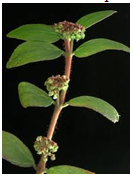
Ginkgo biloba(Ginkgoaceae)
The leaves of Ginkgo are obtained from the dioeceous tree, the only extant species of an otherwise fossile family of the pre-Ice age flora [11]. The extract (0.063-1g/kg, p.o) administered daily for 7 days in Male ddY mice produced Anxiolytic in Elevated plus Maze [24].
Withania somnifera(Solanaceae)
This plant grows widely in all dry parts and subtropical India. The mail constituents of Ashwagandha are alkaloids and steroidal lactones [17]. Intraperitoneal & oral administration of Glycowithanolides (20 & 50 mg/kg) once daily for 5 days resulted in Anxiolytic effects in Rats employed EPM and Social interaction test. The therapeutic potential of Withania somnifera appears to be related inhibition of both the lipid peroxidation & protein oxidative modification [25].
Zingiber officinale(Zingiberaceae)
Ginger (Zingiber) is the scarped or unscraped rhizome of Zingiber officinale. Ginger contains about 1-2% of Volatile oil and 5-8% of resinous matter, starch and mucilage [17]. Animal treated with butanolic fraction showed anxiolytic activity in Elevated Plus Maze [26].
Panax ginseng(Araliaceae)
Ginseng is the dried root of various species of Panax. Ginseng has generated large interest because of its novel pharmacological actions [17]. Ginseng powder and crude saponin ginseng fraction significantly increased the frequency and duration of open arm entries in male ICR albino mice. Pure ginsenoside; ginsenoside Rb1 (2.5 mg/kg; p.o) increased both frequency and duration of open arm entries [27].
Casimiroa edulis(Rutaceae)
It is found in Mexico. Administration of aqueous extract of leaves (25 mg/kg, p.o) to male Wistar rats increased the exploration of open arms in EPM [28].

CONCLUSION
Although 28 species of plants have shown Anxiolytic activity in laboratory animals. All plants have been reported to be effective clinically. Most of the species shows aqueous extract of the plant shows anxiolytic activity on different doses as compared to test and the standard drug Diazepam. Diazepam is the most effective and standard drug used in the Anxiolytic activity in pharmacological actions on Animals.
REFERENCES
1. K.G.Lalitha et al , “Pharmacological Evaluation of Clerodendrum Philippinum Schauer Flowers for Antianxiety and Central Nervous System Depressant Activity” International Journal of Pharmaceutical Research Volume 2, issue 2, 2010, ISSN 0975-2366, Page no. 13
2. Bloom FE, Kupfer DJ. Psychopharmacology: The Fourth Generation of Progress. Raven Press, New York 1994, pp. 1301-1310
3. Reecha Madaan et al,”Evaluation of Anti-anxiety Activity of Actaea spicata Linn”, International Journal of Pharmaceutical Sciences and Drug Research 2011; 3(1): 45-47
4. Nielsen M, Frokjaer S, Braestrup C. High affinity of the naturally-occurring biflavonoid, amentoflavon, to brain benzodiazepine receptors in vitro. Biochem Pharmacol 1988;37:3285-7
5. Dutt V et al,” Antianxiety activity of Gelsemium sempervirens” Pharm Biol. 2010 Oct;48(10):1091-6. doi: 10.3109/13880200903490521.
6. Poonam Mahendra et al, “Anti-anxiety activity of Coriandrum sativum assessed using different experimental anxiety models’, Indian Journal of Pharmacology, Year : 2011 Volume : 43 Issue : 5 Page : 574-577, DOI: 10.4103/0253-7613.84975
7. Mani V, Parle M, Ramasamy K, Abdul Majeed AB. Reversal of memory deficits by Coriandrum sativum leaves in mice. J Sci Food Agric 2011; 1591:186-92.
8. Sarris J et al,” Kava: a comprehensive review of efficacy, safety, and psychopharmacology”, Aust N Z J Psychiatry. 2011 Jan; 45(1):27-35. Doi: 10.3109/00048674.2010.522554. Epub 2010 Nov 15.
9. Kumar S et al, “Anti-anxiety activity studies of various extracts of Turnera aphrodisiaca Ward”, J Herb Pharmacother. 2005;5(4):13-21
10. Rabbanj M at all,” Anxiolytic effects of Echium amoenum on the elevated plus-maze model of anxiety in mice”, Fitoterapia. 2004 Jul; 75(5):457-64.
11. Evans, W.C., Trease and Evans, Pharmacognosy, (15th edition) Saunders: Elsevier, 2009,p 249, 282, 470,277-278,322
12. Dhawan K, “Anxiolytic activity of aerial and underground parts of Passiflora incarnate”, Fitoterapia. 2001 Dec; 72(8):922-6.
13. Amsterdam JD et al, “Chamomile (Matricaria recutita) may provide antidepressant activity in anxious, depressed humans: an exploratory study”, Altern Ther Health Med. 2012 Sep-Oct; 18(5):44-9.
14. Singh Bora K et al,” Evaluation of anxiolytic effect of Medicago sativa in mice”, Pharm Biol. 2012 Jul; 50(7):878-82. Doi: 10.3109/13880209.2011.641227. Epub 2012 Apr 10.
15. Gupta K et al, “Anti-anxiety and anti-depressant activities of Sarasvata choorna in experimental animals”, Ayu. 2011 Oct; 32(4):590-3. Doi: 10.4103/0974-8520.96139.
16. Willis JC, Airyshaw HK, A Dictionary of Flowering Plants and Ferns, Cambridge University Press, London, 1973, p.1214.
17. Kokate C K et al, “Pharmacognosy”, Nirali Prakashan, 36th edition, Sep 2006, 217-218, 518-519, 221
18. Ernst E,” Herbal Remedies for anxiety- a systematic review of controlled clinical trials”, Phytomed, 2006, 13(3), 205-208.
19. Kumar V ,” Potential Medicinal Plants for CNS disorders; An overview, Phytother Res , 2006, 20(12), 1023-1035
20. Jaiswal A K et al,” Anxiolytic activity of Azadirchta indica leaf extract in Rats”, Indian J Exp. Biol,1994, 32(7), 489.491
21. Yanpallewar S et al,” Neuroprotective effect of Azadirchta indica on Cerebral Postischemic reperfusion and hypoperfusion in Rats”, Life Science, 2005, 76(12), 1325, 1338.
22. Freitas M R and Cosra M, “ Anxiolytic and Sedative effects of Extracts & Essential oil from Citrus aurantium L”, Biol Pharm Bull, 2002, 25(12), 1629-1633
23. Lauhers M C et al,” Behavioural effects of E hirta L.: Sedative & Anxiolytic Properties”, J. Ethnopharmacol, 1990, 29(2), 189-198.
24. Kuribara H et al,” An Anxiolytic like effects of Ginkgo biloba extract & its constituents, Ginkgolide- A in Mice”, J Nat Prod, 2003, 66, 1333-1337
25. Battacharya SK et al, “Anxiolytic- depressant activity of Withania somnifera glycowithanolides; an experimental study”, Phytomed, 2000, 7(6), 463-469.
26. Vishwakarma SL et al,” Anxiolytic & Antiemetic Activity of Zingiber officinale”, Phytother Res, 2002, 16(7), 621-626.
27. Carr MN et al,” Identification of Anxiolytic ingredients in Ginseng root using Elevated Plus Maze test in Mice”, Eur J Pharmacol, 2006, 531(1-3), 160-165.
28. Hernandez MM et al, “Anxiolytic- like actions of leaves of Casimiroa edulis in male Wistar rats”, J Ethnophamacol, 2004, 93(1), 93-98.
NOW YOU CAN ALSO PUBLISH YOUR ARTICLE ONLINE.
SUBMIT YOUR ARTICLE/PROJECT AT articles@pharmatutor.org
Subscribe to Pharmatutor Alerts by Email
FIND OUT MORE ARTICLES AT OUR DATABASE










